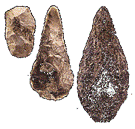Acheulian culture
Acheulian culture, named after French site of St. Acheul, was the first effective colonization of the Indian subcontinent and is almost synonymous with the lower Palaeolithic settlements in India. Remains of Acheulian culture have been found extensively from the Siwalik hills in the north to areas near Chennai in the south but not in the Western Ghats and the coastal region running parallel to them, northeast India and the Ganga plains. Heavy rainfall and dense vegetation in the Western Ghats and northeast India probably inhibited early man from colonizing these regions. In the case of the Ganga plains, the non-availability of stone and the swampy environment may have discouraged early man from occupying them.
- The Acheulian culture was a hunter-gatherer culture that adapted to a variety of climates including but not limiting to western Rajasthan, Mewar plain, Saurashtra, Gujarat, Central India, Deccan plateau, Chota Nagpur plateau and the Eastern Ghats, north of the Cauvery river.
- The sites are densely concentrated in the central India and the southern part of the Eastern Ghats as this area received adequate rainfall, have perennial rivers, a thick vegetation cover and are rich in wild plant and animal food resources.
The most known sediments yielding Acheulian assemblages are found in rock shelter III F-23 at Bhimbetka in Madhya Pradesh . Acheulian people occupied a variety of microhabitats in different regions of India. The hunter-gatherers of Acheulian culture were more concentrated in Nagaur and Didwana of Rajasthan, Vindhya Hills of Central India (Bhimbetaka), Barkhera near Bhimbetka and at Putlikarar in Raisen district of Madhya Pradesh. The rock shelter and open-air sites represent seasonal camping places of the same populations.

Technology in Acheulian Culture
Acheulian tools include the choppers, chopping tools, polyhedrons, spheroids, discoids, handaxes, cleavers, scrapers, denticulates, notches, flakes, blades and cores. They served a variety of functions like hunting, butchering and skinning of animals, breaking bones for extraction of marrow, digging of roots and tubers, processing of plant foods, and making of wooden tools and weapons.
The main raw material used for making the weapons of the Acheulian era was Quartzite, though occasionally quartz was also used. In some parts of India such as Hulgi in Karnataka limestone was the main material.

